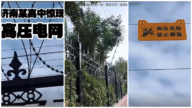【新唐人2014年10月17日讯】中国是世界上建造水坝数量最多的国家。近年来,随着水坝所引发的自然灾害,以及对生态环境的破坏等问题逐渐凸显,使得水坝的负面影响越来越受到人们关注,针对水坝工程建设的质疑还有反对声浪也愈发强烈。日前,一座耗资600多亿元,号称“全球第二大水坝”的水电站在中国大陆的藏区宣布开工后,引发了巨大争议。
据大陆媒体报导,总投资664亿元的中国藏区综合规模最大的水电工程——四川雅砻江两河口水电站,10月6号宣布正式开工,工期10年。据了解,两河口大坝坝高295米,是目前中国第一高的土石坝,也是全球第二大水坝,坝体总填筑量相当于6个“鸟巢”的体积。
尽管当局声称,两河口水电站建成将会“对下游电站产生巨大的补偿调节效益”、“极大改善川渝电网的不合理电源结构”、还能“进一步改善长江上游生态环境”、“增强长江下游防洪能力”等等。但相关专家指出,当局仅仅从水电站本身能起到的有利作用来强调工程的可行性,却完全回避了水电站建设,所带来的巨大而长远的不利影响。
环保志愿者民间水利专家张俊峰:“从我们现在几十年,甚至于工业革命以来到现在为止,我们可以看到很多我们自认为比较稳妥的一些工程措施甚至科学发现,都造成了人类现在的这种环境、生态和自然的一些变化。而有些变化是我们现在还没有认识清晰的,也是无力承担的一些东西。”
多数水利、地质和环保专家们认为,水坝的建设,往往是弊远大于利,其中首当其冲的就是对生态环境的破坏。例如长江上密密麻麻的各级水电站,将长江上游变成了一层层“梯田”,造成了很多洄游鱼类的灭绝,其中包括被称作“水中活化石”的古老珍惜鱼类“中华鲟”。
张俊峰:“从生态的角度来说,由于人为的将河流阻断了之后,使得水体的水生态环境被人为地阻断了。有一些生物体,我们所看到明显的就是一些洄游的鱼类,被阻断了洄游的通道。还有一些其他的,包括水生的微生物和一些其他的微小生物体,也都阻断了它的移动状态。而一旦破坏这样生态系统的一些流动的状态,就会打破当地的一些生态平衡。”
据官方环境评价报告显示,两河口水电站项目施工后,至少将有28种国家级珍稀保护动植物的栖息地受到破坏。但环保人士认为,官方的环评过于片面,并没有把水电工程对生态造成的真正危害公开。
江苏的环保人士吴立红:“我认为建造大坝一定要通过论据的,要有周边百姓的同意,要有相关科学数据拿出来,要拿出真实的环境报告,环境评价要公开,现在我们大陆的环境评价都是假的呀!它为了(工程)要通过,所以下面的一些政府机构它就搞假的环评。”
除了对物种、水体、气象等生态环境造成的影响和破坏,水坝对于地质的影响也是极为巨大的,由此而导致的地震、山体滑坡、泥石流、洪水等自然灾害也屡屡发生。
张俊峰:“雅砻江地区属于地质比较活跃的地带,如果要是一旦建设一些水电站的话,势必对地质的状况会产生一些干扰,而这种干扰一定会对当地的地质产生一些影响,而且是比较深刻的影响。我认为这种影响会有可能引发一些诸如地震或者其他的一些地质上的一些危害。”
如果说,对于“全球最大坝”——长江三峡工程持续几十年的争议仅仅限于专家学者的范围,那么“全球第二大水坝”两河口水电站宣告的开工,则引发了更大范围的争议,网路上出现了一面倒的反对声音。
网民们有的怒骂当局“祸害地球,不顾及子孙后代”﹔有人“坐等生物灭绝”﹔有的反问“为何国外在拆,中国在建?”﹔有人嘲讽“又肥了哪个利益集团?”有居住在水库区的网民则质问当局“当初的承诺,为何至今无一兑现?”
采访/田净 编辑/张天宇 后制/李智远
China Starts Building Controversial Dam in Tibet
China owns the largest number of dams in the world.
The prominent issues of natural disasters and ecological
destruction from the dams have brought more questions
and strong opposition to hydropower.
Construction on the largest in dam in Tibet, costing over
60 billion yuan ($9.8 billion), is stirring intense controversy.
Mainland media report that construction on the $10.8 billion
hydropower station on Yalong River in Sichuan
began on Oct. 6, and is expected to be completed in 2023.
The dam will be 295 meters high, and will be the tallest dam
in China and the second tallest in the world.
The dam will have a total filling volume equal to six
Bird’s Nests, Beijing’s Olympic Stadium.
The authorities say that the hydropower station will improve
the adjustment capacity of downstream stations,
the imbalanced Chongqing power grid structure,
the ecological environment of the Yangtze River’s
upper reaches, and the Yangtze River flood control capacity.
But experts say the benefits were only mentioned
to emphasize the feasibility of the construction,
while the long-term adverse effects of the station
are completely being ignored.
Zhang Junfeng, water resources expert: “For decades now,
since the Industrial Revolution and even up to now,
we can see that a lot of what we believed,
in terms of the engineering and scientific development,
have changed our environment, ecology and nature.
We have yet to understand some of these changes,
and we are completely unable to handle them."
Most experts in water conservancy, geology and environment
believe that the construction of dams often do more harm
than good, particularly when it comes to ecological damage.
For example, dense hydropower stations on the Yangtze River
have turned areas upstream of the river into layers of “terraces",
pushing many migratory fish to extinction, including the fish
known as the “living fossil in the water," the Chinese sturgeon.
Zhang Junfeng: “From an ecological perspective, the dam has
artificially destructed the ecological environment in the water.
The channel of the migration for some organisms,
such as the migratory fish, have been blocked.
Some water born microorganisms and other tiny organisms
are also blocked of its mobile state.
Once the flow of the ecosystem is destroyed,
so to will the local ecological balance."
The official environmental assessment report shows that
after the construction of dam, the habitat for at least 28 kinds
of rare and protected plants and animals of the national level
will be destroyed.
But environmentalists say that the official assessment is too
one-sided, and hasn’t fully revealed the true ecological harm
of the hydropower project.
Wu Lihong, environmentalist in Jiangsu: “I think construction
of the dam must pass arguments, have consent of neighboring
residents, consider scientific data, and environmental reports;
the environmental assessment must be made public.
Now the environmental assessments in China are fake!
In order to pass projects,
the government agencies make up fake assessments."
Other than the impact and damage to species of life, water,
and weather, the ecological destruction caused by dams
is also huge, leading to frequent natural disasters
such as seismic activity, landslides, mudslides, and floods.
Zhang Junfeng: “Yalong area belongs to the more active
geological zones, the construction of dams is bound to produce
some geological interference, which will have more profound
impact such as earthquakes or other geological hazards."
If the construction of the Yangtze River Three Gorges Project,
“the world’s largest dam," has caused decades of controversy
among experts and scholars, the Yalong River dam has caused
even wider disputes among the public since its construction.
Many netizens posted online criticisms of the authorities,
saying, “scourge of the earth, disregarding present
and future generations"; “waiting for extinction";
“Why they are being demolished overseas, but built in China?";
and “which interest groups have been benefited?"
A resident around the reservoir area questioned the authorities:
“Why hasn’t even one promise ever been honored?"
Interview/TianJing Edit/Zhang Tianyu Post-Production/Li Zhiyuan




























